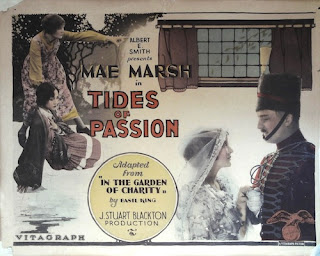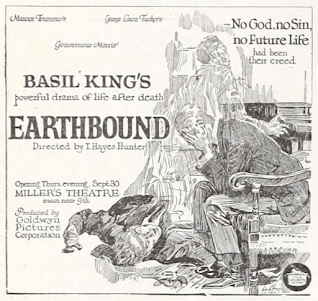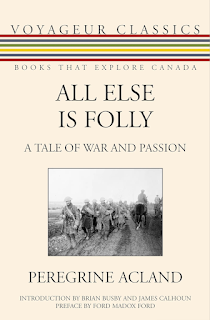The Street Called Straight
By the author of The Inner Shrine [Basil King]
New York: Harper, 1912
415 pages
Olivia Guion seems a most dislikable character. As a young woman of eighteen she quite literally turned her back on a marriage proposal. Olivia had not said a word, rather she'd stood up and, "fanning herself languidly, walked away."
See what I mean?
The young man left seated awaiting her reply was Peter Davenant. His love for Olivia was such that he could not help himself, even though he expected rejection.
But silence?
At thirty-three, Davenant is again seated next to Olivia, this time as the last minute substitute at a dinner party hosted by her father. She pretends that they've never met, while Davenant is so modest as to believe that she does not remember him. Olivia engages in polite conversation – "Twice round the world since you
were last in Boston? How interesting!” – before turning to the other guests with animated talk about her forthcoming marriage to dashing Lieutenant-Colonel Rupert Ashley of the Sussex Rangers.
After the final course, the ladies retire to another room leaving Davenant alone with Olivia's father Hector Guion and her much older cousin Rodney
Temple, Director of the Department of
Ceramics in the Harvard Gallery of Fine Arts. Davenant's evening becomes still more uncomfortable as unwitting and unwilling witness to Guion admission that he.... Well, what exactly?
Hector Guion is one of the most respected men in Boston. He heads an investment firm, established by his grandfather, which handles the old money of Old Money. Guion appears to have brought the business to new heights, as evidenced by his increasingly lavish lifestyle, when in fact Olivia's papa has been embezzling his clients' investments. Now, the jig is up. Guion expects the evening will be his last as a free man.
Peter Davenant is an entirely different sort. His entrée to the dining table shared by Guoins and Temples comes by way of adoption. Born Peter Hallett, "his parents according to the flesh" were missionaries in China. Both died young, leaving their church to care for their son. He spent several years in an orphanage before being taken in and given a new name by childless Bostonians Tom and Sarah Davenant. Thus was the boy elevated to a level that would, at age twenty-four, bring the humiliating marriage proposal.
As the narrator notes, "the years between twenty-four and thirty-three are long and varied." In those nine years, Davenant amassed a significant fortune through an investment in a copper mine somewhere in the region of Lake Superior. These newfound riches cut Davenant loose from all moorings, setting him adrift. He has indeed been twice around the world since leaving Boston. On his second tour du monde Davenant returns to the Chinese city of Hankou, his birthplace.
 |
| Hankou, China, c.1880, about the time Davenant would have been born. |
Before then, he'd known very little of his schoolteacher mother and physician father. Davenant reads hospital records written in his father's hand, visits his mother's grave, and finds the place at which their modest home had once stood:
It was curious. If
there was anything in heredity, he ought to have felt
at least some faint impulse from their zeal; but he
never had. He could not remember that he had
ever done anything for any one. He could not remember that he had ever seen the need of it. It
was curious. He mused on it – mused on the odd
differences between one generation and another, and
on the queer way in which what is light to the father
will sometimes become darkness in the son.
It was then that he found the question raising
itself within him, “Is that what’s wrong with me?”
The query took him by surprise. It was so
out of keeping with his particular kind of self-respect that he found it almost droll. If he had never
given himself to others, as his parents had, he had
certainly paid the world all he owed it. He had nothing wherewith to reproach himself on that score.
And yet, Peter Davenant (né Hallett) does reproach himself.
Back in Boston, in the aftermath of the dinner party, he decides to rescue Hector Guion by giving him his riches. Olivia is another beneficiary in that the gift will enable the Guion family to dodge a scandal that might otherwise endanger her engagement to Rupert Ashley. Hector Guion is eager to accept the offer, but not so his daughter... until she realizes that several elderly women might be cast out on the street as a result of her father's transgression.
All looks to work out until Ashley arrives from the Old Country and thrusts a spanner into the works.
There is much to admire about Basil King's novels, intricate plots being foremost. The Street Called Straight is an exception. Though simple, it is no less enjoyable owing to the ways in which the story affects its characters. Hector Guion is the first to undergo transformation.
 |
| Harper's Magazine, February 1912 |
The years between twenty-four and thirty-three are indeed long and varied, but so too are the years between eighteen and twenty-seven. No one character is stronger and more attractive than the woman who at age eighteen walked away from a marriage proposal fanning herself.
Bloomer: This one is far longer than the norm. Bear with me.
We begin with Devenant being in "a position from which he could not withdraw," facing "a humiliation to be dislodged from." I'm probably making too much of his moments "face to face with Olivia Guion" and am really going out on a limb with "laying up the treasure," but the final two sentences most certainly qualify as a bloomer:
As he was
apparently able to shoulder it, it would have been
better to let him do it. In that case he, Peter Davenant, would not have found himself in a position
from which he could not withdraw, while it was
a humiliation to be dislodged from it.
But, on the other hand, he would have missed
his most wonderful experience. There was that
side to it, too. He would not have had these moments face to face with Olivia Guion which were to
be as food for his sustenance all the rest of his life.
During these days of discussion, of argument, of
conflict between his will and hers, he had the entirely
conscious sense that he was laying up the treasure
on which his heart would live as long as it continued
to beat. The fact that she found intercourse with
him more or less distasteful became a secondary
matter. To be in her presence was the thing essential, whatever the grounds on which he was admitted there.
Trivia: Published anonymously in May 1912, all that was known was that the same hand had penned The Inner Shrine, which had been biggest selling novel of 1909. There had been suggestions that Edith Wharton or Henry James had written that novel and its follow-up The Wild Olive (1910).
In 1912, The Street Called Straight was the second biggest selling novel in the United States. In 1910, The Wild Olive had made only number three.
Object and Access: An attractive hardcover in crimson boards with gold type featuring eight illustrations by American artist Orson Lowell (1871-1956).
A first edition, I purchased my copy in error. What I'd meant to order was a
signed first edition from the very same bookseller. It set me back US$100. The signed copy was US$125.
I regret nothing.

The book's healthy condition was no doubt aided by the notice that appears on its front flap (right).
As I write, just one copy of the first edition in jacket is listed online. Price: US$100. A jacketless copy in not so great condition is being offered by a Nova Scotia bookseller at C$5, which seems an incredible bargain.
The British first, published in 1912 by Methuen, is nowhere in sight, though later printings are available for purchase.
In 1920, Grosset & Dunlop issued a photoplay edition with plates from the film. Copies start at US$13.50.
The novel first appeared – or began appearing – as a serialization that ran in Harper's Monthly Magazine during the first seven months of 1912. The book landed in bookstores in the fifth month of that year.
The Street Called Straight is available online in both book form and serialization courtesy of the Internet Archive. Those who choose to read the novel in serialization will be rewarded with four Lowell illustrations that were not included in the finished product. I've included one of the February 1912 illustrations above, but this one from January 1912 is by far my favourite:




























































